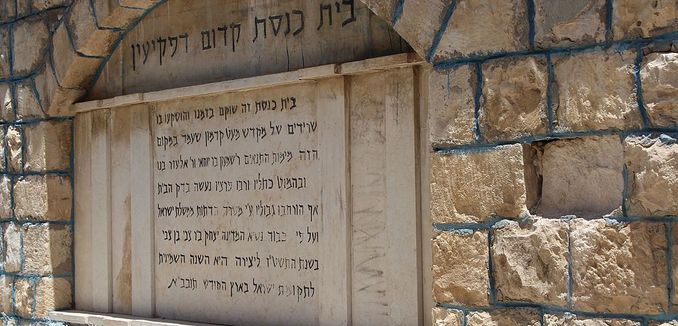Archaeologists have discovered and restored a stone column with Hebrew inscriptions from an 1,800-year-old synagogue in the town of Peki’in in the western Galilee region, the Israeli Antiquities Authority (IAA) announced this week.
The column was found as part of the Authority’s work on the ancient synagogue in Peki’in.
“The stone was found upside down in the building’s courtyard, and upon discovery of the inscriptions, archeologists from the IAA arrived at the site to examine the special find,” the IAA said in a statement Tuesday. “A preliminary analysis of the engravings suggests that these are dedicatory inscriptions honoring donors to the synagogue.”
Yoav Lerer of the IAA explained to The Jerusalem Post that the Talmud tells of numerous sages who lived in the area at the time, including Rabbi Shimon ben Zakai. While some doubt that modern Peki’in is the same Peki’in mentioned in the Talmud, Lerer said, “I believe that these inscriptions will add an important tier to our knowledge about the Jewish settlement in the village of Peki’in during the Roman and Byzantine periods.”
Uriel Rosenboym, director of a visitors’ center devoted to the 2,000-year history of Jews in Peki’in, called the pillar a “historical discovery of unparalleled importance.”
“No one can argue with a written artifact,” Rosenboym explained. “There was an ancient synagogue here, and the synagogue was built in its current form in recent centuries. We thank the Ministry of Jerusalem Affairs and Heritage, which aims to preserve the heritage of Peki’in’s Jews.”
“It is a place where there has always been a Jewish presence,” Minister of Jerusalem Affairs and Heritage Ze’ev Elkin said in a statement. “It’s a great honor for me that during my tenure in office such an important discovery has been made that tells this 2,000-year-old story of the Land of Israel.”
Numerous other archaeological discoveries of Israel’s ancient Jewish history have been made in the past year.
In July, mosaics showing two biblical scenes from a synagogue were discovered elsewhere in the Galilee. Two months later, a burnt scroll from the same time period containing the earliest known copy of biblical scriptures in their current form was was reconstructed by scientists.
A study published last April that analyzed 100 written messages found on pottery shards near the Dead Sea determined that more people were able to read and write Hebrew during the First Temple period (around 600 BCE) than was previously believed.
In March, two seals bearing Hebrew names were unearthed in the remains of a building from the First Temple period in Jerusalem. The finding was particularly noteworthy as one of the names — Elihana bat Gael — was of a woman. “Seals that belonged to women represent just a very small proportion of all the seals that have been discovered to date. This is because of the generally inferior economic status of women, apart from extraordinary instances such as this,” Prof. Hagai Misgav of the Hebrew University of Jerusalem explained at the time.
The discovery in 2013 of 2,500-year-old Jewish artifacts in Jerusalem prompted Prime Minister Benjamin Netanyahu to call such finds “historic testimony, of the highest order, to the Jewish People’s link to Jerusalem, to its land and to its heritage.”
[Photo: Deror avi / WikiCommons ]




